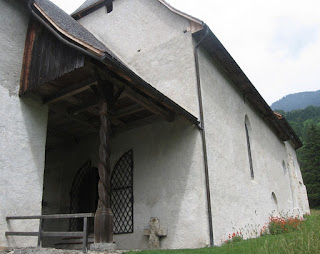 |
| Altarpiece relief depicting St. Martin and the beggar. |
Today we celebrate the feast of St. Martin of Tours, a 4th-Century monk and bishop in what is now France
According to tradition, just before his baptism, while riding his horse in carrying out his military duties, Martin encountered a shivering beggar. He removed his cloak, and with his sword, he cut it in two, giving half to the beggar. Later, in a dream, Christ appeared to him as the beggar he had clothed.
When I was in Europe last year, I visited many, many, many churches, and had the opportunity to see and pray in some magnificent, historic cathedrals and basilicas. Most of these had undergone a number of changes through the centuries due to wars, fires, etc., and many were adorned interiorly in the fanciful Baroque style.
However, my favorite church as a visitor wasn’t any of these. Rather, it was a small, humble, and much older country church located just above the mountainside village of Ludesch in Austria St. Martin , and is one of the loveliest, most well-preserved old churches I have ever seen. Many aspects of the church and its setting spoke to me in ways none of those bigger, more famous and richly adorned churches did. I could have spent the entire day there.
 |
| Looking out from the breezeway between the church and the bell tower. |
The stone and stucco structure of St. Martin ’s (with walls about 4 feet thick) was built around 1400, but evidence suggests its history stretches back at least a couple hundred years earlier. The current interior architecture, artwork, and Gothic furnishings date to about 1600. Also included above the altar is a Romanesque crucifix from around 1200.
So, in honor ofSt. Martin , and recalling this wonderful church, I am posting here some photographs I took during my visit in June 2010. Enjoy.
So, in honor of
 |
| Thick walls! |
 |
| Sanctuary interior with benches and kneelers (15th or 16 Century). These, on the right, were for men. The women, who did not have to kneel, sat on the left on similar benches but with no elbow rests. |
 |
| Many frescoes on the walls and ceiling depict the life of Christ. |
 |
| Just outside the church overlooking the village. |
 |
| Idyllic setting. |







No comments:
Post a Comment